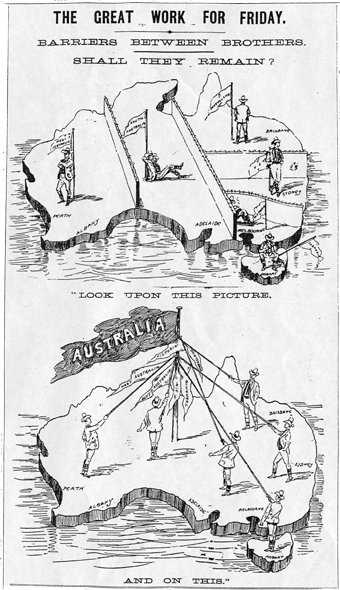Six Colonies
By the end of the 1860s, all the Australian colonies except Western Australia had been granted self government by Britain. Each had a written constitution in the form of an act of the British Parliament which established a legislature consisting of two houses.
A strong sense of identity had developed among the people of each colony. Geographical isolation, and in some cases privation, had fostered a feeling of rivalry between the colonies, which sometimes deepened to suspicion and distrust.
A complex system of tariffs governed the movement of goods between the colonies. Systems of road, rail and river transport began and ended on colonial borders. And each colony maintained a small militia, totally inadequate for the defence of Australia’s long coastline.
|
|
|
|
‘Boomerang versus cannon’
Punch (Melbourne), 8 August 1889
Australian War Memorial
In 1889 a report by a British Major-General, Sir James Bevan Edwards, recommended that the colonial military forces unite under a single command. But on this and other issues, selfishness, jealousy, obstinacy, internal rows and insularity prevented the colonies from cooperating. |
|
The last meeting of the Federal Council of Australasia, 1899
National Library of Australia
A Federal Council of colonial representatives with the capacity to make laws in some areas affecting all the colonies met on a number of occasions between 1886 and 1899. The Council had limited legislative powers, which did not include, for example, powers in relation to tariff policy. It was handicapped also by its lack of ability to raise revenue for its own purposes, and by the refusal of New South Wales, and for a great deal of its life, South Australia, to participate. |
Conferences hitherto have produced a minimum of result. Resolutions have been passed over and over again, but as there existed no common legislative body to give them force the greatest part of them remained a dead letter.
James Service, Premier of Victoria, 1883
For many years, intercolonial meetings on tariffs, transport and defence produced little real result. |
|
| |
‘The spirit of federation—principally jaw’
The Bulletin (Sydney), 14 June 1890 |
 |
As the prospect of the colonies uniting to form one nation strengthened towards the end of the nineteenth century, it became evident that the only form of union which would be acceptable to all the six independent colonies would be a federation; that is, a union in which the sovereign rights and legislative powers of the colonies were maintained and only certain defined powers were given to a central government. |
Barriers between brothers: shall they remain?’
Argus (Melbourne), 1 June 1898 |
When New South Wales Premier Henry Parkes took up the cause in earnest in the late 1880s, federation acquired its most powerful and persistent champion to that time.
Parkes declared at Tenterfield (NSW) in October 1889 that the time had come for 'a great national government for all Australia', and called on the colonial parliaments to send representatives to a conference to consider means of drafting a federal constitution.
At the Australasian Federation Conference held in Melbourne from 6 to 14 February 1890, leading politicians from the six Australian colonies and New Zealand affirmed the desirability of ‘the union of these Colonies, under one legislative and executive Government, on principles just to the several colonies.’ They committed themselves to persuading their governments to send delegates to a convention which would ‘consider and report’ on a scheme for a federal constitution. It was agreed that the delegates were to discuss not whether to unite, but how.
|
Henry Parkes in his office while Premier of New South Wales
National Library of Australia |
|
Delegates to the Australasian Federation Conference, Melbourne, 1890
National Library of Australia
The bearded figure of Henry Parkes is central in this portrait of the delegates to the 1890 conference. The delegates were all leading members of colonial governments, and included a number who were to play a leading role in bringing federation about, including Andrew Inglis Clark, back left, Samuel Griffith, third from left at back, and Alfred Deakin, sixth from left at back. |
|


